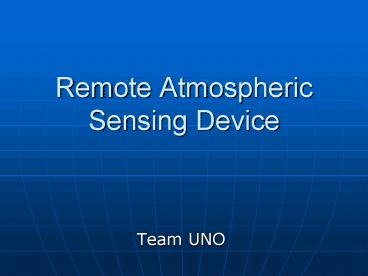Remote Atmospheric Sensing Device - PowerPoint PPT Presentation
1 / 14
Title:
Remote Atmospheric Sensing Device
Description:
Measure total column thickness of the ozone layer ... 8 16 Kb FRAM units. Pressure Detection. Temperature Detection/Regulation. New Electrical Design ... – PowerPoint PPT presentation
Number of Views:54
Avg rating:3.0/5.0
Title: Remote Atmospheric Sensing Device
1
Remote Atmospheric Sensing Device
- Team UNO
2
Team UNO
- Donald Swart
- Cindy Gravois
- René Langlois
- UNO Advisor
- Lawrence Blanchard
3
Objectives
- Using the measurable quantities of UV intensity
- Measure total column thickness of the ozone layer
- Measure relative ozone concentration as a
function of altitude - Measure UVB and UVC as it is transmitted and
attenuated through the stratosphere
4
Expected Results
- Flight profile
- 0 to 30km
- Approximately 90 minute flight
- Increasing UV intensity with increasing altitude
- Largest change at about 15km
- The curve shown on this graph represents ozone
density as a function of altitude - Using ozone coverage estimates for the area of
Palestine, TX provided by NOAA and taken over the
last 3 years during this week we should see about
320 DU of ozone coverage.
5
Failure to Launch
- Lack of proper program code
- Programmer quit without warning or writing code
- Progress reports were falsified
- Processor Damaged
- Insufficient time to rework an entirely new
circuit design
6
Electrical Design
- Detector Array
- Filtered Photo diodes
- Dark Current Compensation
- Controller
- PIC16F917
- 8 16 Kb FRAM units
- Pressure Detection
- Temperature Detection/Regulation
7
New Electrical Design
- BalloonSAT
- 2 bad BalloonSAT boards before good board found
- Required team members to learn a new programming
language in less than a day - Voltage regulator broke off during final testing
- Advantage greater on board memory
8
Mechanical Design
- Box
- 8x6x5 inches
- Allows space for all components
- Reflective tape to prevent overheating
- Insulation
- Styrofoam sheets
- 1 inch of exterior foam retains heat
- Provides support for inner electronics
9
New Mechanical Design
- Outer box size unchanged
- Inner box had to be adjusted to accommodate a
completely new circuit - Wasted mass due to insufficient time to reduce
box size - Advantage more insulation
10
Power System
- Main Payload and Diodes
- Energizer CR 2025 batteries
- 3 V, 170 mAh each
- Heater
- Energizer CR 2025 batteries
- Stacked to provide 6V
- CR 2025 are very lightweight
- 9 total used, less mass than standard 9 V battery
- Can last 5 hours with a constant draw of 30 mA
11
New Power Design
- BalloonSAT required 9V input and had a greater
current draw than PIC - 2 9V batteries were used which consumed more mass
than original power system
12
Final Conclusions
- Forced use of completely new circuit design
- Lack of adequate programming for PIC
- Lost time for proper testing
- Short circuited PIC
- Not found sooner due to misinformation from a
faculty advisor - Lack of time for overall testing in new circuit
13
Lessons Learned
- More thorough progress reporting steps
- More team communication
- Common working times and locations
- Cross training on all aspects of essential
payload design and processes - i.e. in the event of loss of the programmer
- Greater emphasis on cross training
14
Acknowledgements
- LACES
- Dr. Brad Ellison
- Dr. Greg Guzik
- Stennis Space Center
- Lester Langford
- UNO
- Dr. Greg Seab
- Dr. Terry Reamer
- Dr. Edit Bourgeois
- Dr. Azzam































